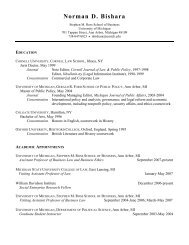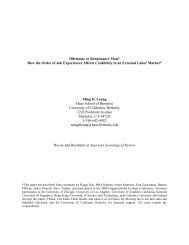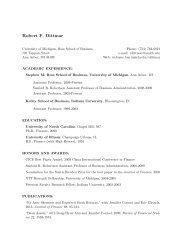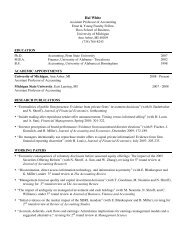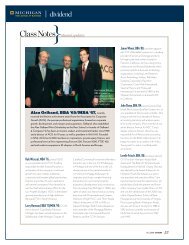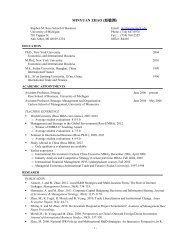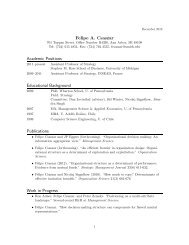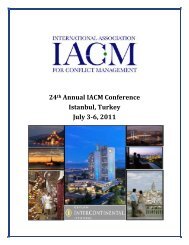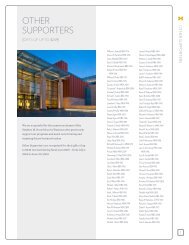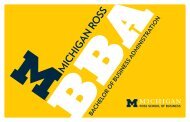DIvIDEnD - Stephen M. Ross School of Business - University of ...
DIvIDEnD - Stephen M. Ross School of Business - University of ...
DIvIDEnD - Stephen M. Ross School of Business - University of ...
Create successful ePaper yourself
Turn your PDF publications into a flip-book with our unique Google optimized e-Paper software.
<strong>Ross</strong> Pr<strong>of</strong>essors help Shape Report on<br />
carbon, Midwest Economic Revival<br />
Pr<strong>of</strong>essors Tom Lyon and Andy H<strong>of</strong>fman were<br />
advisers on a new national report examining how<br />
the midwest could add jobs and revenue from<br />
changes in u.s. climate and energy policy.<br />
American Innovation: Manufacturing Low<br />
Carbon Technologies in the Midwest was issued<br />
in January by the climate group, a nonpr<strong>of</strong>it<br />
organization established to find ways to cut global<br />
emissions. the report estimates that climate and<br />
energy policies could create up to 100,000 new<br />
jobs in the midwest and generate additional<br />
market revenues <strong>of</strong> up to $12 billion, boosting state and local tax revenues<br />
by more than $800 million by 2015. these gains were estimated from policy-<br />
assisted growth in the wind turbine component, hybrid powertrain, and<br />
advanced battery manufacturing sectors.<br />
the report considers the impact <strong>of</strong> three climate and energy policies:<br />
a $17-per-ton price on carbon in 2015, resulting from a cap on emissions;<br />
a national renewable electricity standard <strong>of</strong> 20 percent by 2020; and a green<br />
economic stimulus package. it compares job and revenue growth in michigan,<br />
illinois, indiana, ohio, and wisconsin with and without these policies.<br />
michigan could see more than 32,000 new jobs created, more than $4 billion<br />
in market revenue, and about $244 million in state and local tax revenue<br />
through 2015, the report states.<br />
lyon and h<strong>of</strong>fman assisted in designing the assumptions and criteria<br />
to undertake the economic analysis, and reviewed the report’s content.<br />
Deloitte financial advisory services completed the economic analysis<br />
and background research.<br />
lyon is director <strong>of</strong> the erb institute for global sustainable<br />
enterprise, a partnership between <strong>Ross</strong> and u-m’s school <strong>of</strong> natural<br />
Resources and environment. he is an authority on corporate environmentalism<br />
and the interplay between corporate strategy and public<br />
policy. he is the Dow Pr<strong>of</strong>essor <strong>of</strong> sustainable science, technology,<br />
and commerce; a pr<strong>of</strong>essor <strong>of</strong> business economics; and a pr<strong>of</strong>essor <strong>of</strong><br />
natural resources. h<strong>of</strong>fman is associate director <strong>of</strong> the erb institute<br />
and an expert on managerial implications <strong>of</strong> environmental protection<br />
and social sustainability for industry. he is the holcim (u.s.) Pr<strong>of</strong>essor<br />
<strong>of</strong> sustainable enterprise, an associate pr<strong>of</strong>essor <strong>of</strong> management and<br />
organizations, and a pr<strong>of</strong>essor <strong>of</strong> natural resources. —Kevin Merrill<br />
Energy club Seeks to cut Through carbon haze<br />
James Rogers, chairman and CEO <strong>of</strong> Duke Energy, set the tone at the <strong>Ross</strong> Energy Club’s second<br />
annual Carbon Symposium in September when he called for the U.S. government to make a move<br />
on carbon regulations. “I want action now,” he said. Rogers and the North Carolina-based electric<br />
power company have been at the forefront in the utility industry <strong>of</strong> finding workable alternatives to<br />
burning fossil fuel and supporting some sort <strong>of</strong> cap-and-trade legislation.<br />
Erb Graduates Publish Book<br />
on Hybrid organizations<br />
An increasing number <strong>of</strong> today’s business<br />
students want to work for companies that<br />
are “doing good and doing well,” according<br />
to the authors <strong>of</strong> Hybrid Organizations: New<br />
<strong>Business</strong> Models for Environmental Leadership<br />
(Greenleaf, 2009).<br />
“Right now there’s another wave <strong>of</strong> the green<br />
revolution,” says Emily Reyna, MBA/MS ’09,<br />
one <strong>of</strong> five Erb Institute graduates who<br />
contributed to the book. “People are realizing<br />
we have limited resources and want to work<br />
for companies that are cognizant <strong>of</strong> that.”<br />
While the concept <strong>of</strong> hybrid organizations is<br />
not new, there is a lack <strong>of</strong> research and literature<br />
on how these companies work, say the authors.<br />
They were eager to shed light on organizations<br />
they define as market-oriented, mission-<br />
centered, and focused on the common good.<br />
“They can’t just be a company with one<br />
‘green’ product. They have to be more holistic,”<br />
says Daniel Wang, MBA/MS ’08.<br />
Wang, Reyna, and co-authors Brewster<br />
Boyd, MBA/MS ’09, nina Henning, MBA/<br />
MS ’09, and Matthew Welch, MBA/MS ’08,<br />
worked with faculty adviser Andy H<strong>of</strong>fman,<br />
associate director <strong>of</strong> the Erb Institute and the<br />
Holcim (U.S.) Pr<strong>of</strong>essor <strong>of</strong> Sustainable Enterprise,<br />
to collect data from 47 companies that<br />
fit their description <strong>of</strong> a hybrid organization.<br />
They chose only for-pr<strong>of</strong>it companies and<br />
put no restriction on the size or age <strong>of</strong><br />
the firm. They reviewed business models,<br />
strategies, finances, organizational structures,<br />
processes, metrics, and innovations<br />
<strong>of</strong> hybrid organizations. Then the team<br />
selected five companies for in-depth<br />
case studies: Sun Ovens International, Guayakí,<br />
Eden Foods Inc., Maggie’s Functional Organics,<br />
and PAX Scientific Inc.<br />
The authors conclude that hybrids <strong>of</strong>fer an<br />
effective organizational model for contributing<br />
to global environmental issues. They argue,<br />
“While there may be limits to the speed <strong>of</strong><br />
growth or scaling for these organizations, they<br />
may be more effective and self-sustaining than<br />
traditional organizations in meeting humanity’s<br />
common challenges.” —Leah Sipher-Mann<br />
spring 2010 <strong>DIvIDEnD</strong> 13



